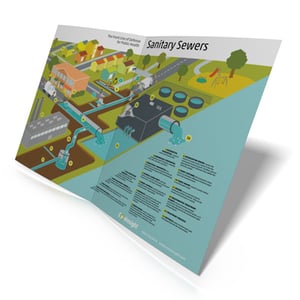 Sanitary sewer systems are critical to the U.S. economy and to protecting public health and the environment. But because they're hidden from sight, few outside the water and wastewater industry understand their operation. The Environmental Protection Agency (EPA) regulates more than 151,000 public water systems in the United States that serve 90% of Americans—that’s more than 290 million people who rely on sanitary sewers!
Sanitary sewer systems are critical to the U.S. economy and to protecting public health and the environment. But because they're hidden from sight, few outside the water and wastewater industry understand their operation. The Environmental Protection Agency (EPA) regulates more than 151,000 public water systems in the United States that serve 90% of Americans—that’s more than 290 million people who rely on sanitary sewers!
These water systems extend roughly 800,000 miles and traverse rural and urban towns and municipalities snaking under streets, sidewalks, homes and businesses; approximately half are publicly owned, and half are privately owned. It may be challenging to describe the complex path that wastewater takes to people who are new or unfamiliar with sanitary sewer systems, but understanding whose responsibility lines belong to for maintenance, repair and associated costs is vital to operation and public safety.
Used water from kitchen and bathroom sinks, showers, washing machines and dishwashers is referred to as greywater; wastewater from toilets is referred to as blackwater. Greywater is generally safer and easier to treat compared to blackwater but regardless of the number of contaminants, all the wastewater that goes down the pipe from homes and businesses ultimately ends at the wastewater treatment plant to be purified before being discharged back into the environment.
Property owners must be aware of the wastewater discharge from their home or business because property owners are responsible for all of the internal pipes in the building as well as the lateral cleanout and sewer lateral lines. Lateral cleanouts can be found in yards, basements and crawl spaces and provide easy access to the sewer lateral line. Sewer laterals connect properties to the public sewer system. Plumbers and drain cleaning professionals specialize in repairing and servicing these smaller lines—everything from the sink to the sewer lateral.
After passing through the lateral lines, wastewater enters sewer main pipes and becomes the responsibility of the municipality or local public works department. These organizations are charged with ensuring the wastewater safely continues its journey through the various main lines and pump stations, to the treatment plant basin, through the treatment plant, and finally through outfalls back into the environment. The repair and servicing of any manholes, lifts, leaks or broken pipes along this journey falls to the local governing body.
Demystifying wastewater collection systems and explaining their value and operation is essential for property owners to understand—for building public support, and for securing funding to repair infrastructure. To aid wastewater professionals tasked with explaining the unseen, Envirosight has developed a new poster: Anatomy of a Sanitary Sewer. This resource illustrates the general architecture of U.S. sanitary sewer collection systems and shows how they work in a way that makes it easy for anyone to comprehend.
Request your free copy now:

